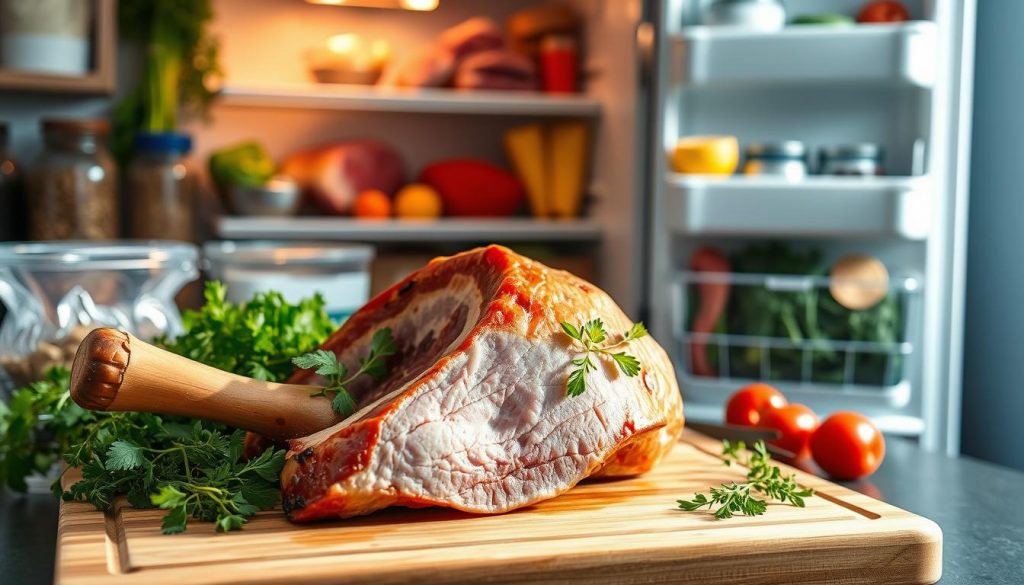When we gather for festive meals, the ham is often the star. After the meal, we’re left with a ham bone that’s too good to throw away. It’s important to know how to store leftovers safely to keep the ham bone fresh for future meals. The U.S. Food and Drug Administration (FDA) says to refrigerate cooked ham leftovers, including the bone, to avoid spoilage and illness.
Ham bones can stay in the fridge for three to four days if they’re in a sealed container. But, they last longer in the freezer. If you want to keep the taste of your feast alive, freezing is the way to go. Wrap the ham bone in a vacuum-sealed bag to prevent freezer burn. Make sure to label it with the date and keep it frozen for up to three months for the best flavor.
Key Takeaways
- Refrigerate leftover ham bones immediately to ensure fridge food safety and to prolong ham bone shelf life.
- The FDA recommends keeping cooked ham leftovers, including ham bones, in the fridge for up to four days in a sealed container.
- For longer storage, freeze the ham bone in a vacuum-sealed bag with the air removed and label it with the date to maintain freshness.
- Honor the recommended use of frozen ham bones within three months to preserve flavor and quality.
- Understanding proper leftover ham storage techniques is key to reducing food waste and enjoying holiday meals longer.
Understanding Ham Preservation After the Holidays
After the holidays, leftover ham fills your fridge. It’s key to know how to keep it fresh. We’ll cover how to cool it down fast, store it right, and follow USDA guidelines. This way, your ham stays safe and tasty for longer.
Importance of Refrigeration for Leftover Ham
Keeping your holiday ham cool is the first step. The USDA says to keep it below 40 degrees Fahrenheit. This slows down bacteria growth and keeps your ham safe and good to eat.
How Quick Cooling and Airtight Packaging Impacts Shelf Life
Quick cooling and airtight packaging are key to keeping your ham fresh. Remove the ham from the bone and cool it down fast. Then, store it in airtight containers or wrap it tightly. This keeps it moist and prevents odors.
Pro-tip: Store sliced ham in a sealed container with a folded paper towel at the bottom. This catches excess moisture and keeps your slices fresh.
USDA Guidelines on Leftover Ham Storage
The USDA has clear guidelines for storing ham. Cooked ham should be eaten within three to five days in the fridge. If you need to freeze it, wrap it well and mark the date. Frozen ham should be eaten within two months for the best taste.
Following these guidelines helps your ham last longer and stay safe to eat. It ensures your ham is delicious for your post-holiday meals.
The Duration of Ham Bone Freshness in the Refrigerator
Keeping the ham bone freshness after a big meal is key for its safety and quality. We’re talking about how to keep it fresh longer and safe to eat later. This is all about making the most of your leftover ham.
A leftover ham bone is full of flavor waiting to be used. Food safety experts say you can keep a cooked ham bone in the fridge for 3 to 4 days. But, if you need more time, the right wrapping and storage can help.
| Type of Ham | Fridge (Days) | Freezer (Months) |
|---|---|---|
| Fully-cooked, unopened | 14 | 2 |
| Ham bone | 3-4 | 2 |
| Sliced or spiral-cut | 3-5 | 2 |
| Fresh or uncured, cooked | 3-4 | 3-4 |
- Wrap the ham bone in plastic or foil and store it in the coldest part of the refrigerator to maximize its freshness.
- Consider the timing: Food that’s refrigerated within 2 hours of cooking is far likelier to be safe for later consumption, as it minimizes the risk of bacterial growth.
- Assessing the freshness of ham involves checking for off-smells, discoloration, or a slimy texture, indicators that the ham should be discarded.
Following these steps keeps your leftover ham safe and fresh. It’s ready to add flavor to your next meal. Always be cautious with leftover ham and throw it away if unsure.
Freezing Your Ham Bone: Ensuring Longevity and Flavor
When the holiday ham is gone, freezing the bone is a lifesaver. It keeps the bone’s flavors for soups and broths. This way, you can enjoy it for months to come.
Vacuum Sealing Versus Traditional Freezing Methods
Vacuum sealing benefits are huge. It removes air, preventing freezer burn and keeping flavors and textures. If you don’t have a vacuum sealer, use plastic wrap and foil to wrap the bone tightly.

Experts say pre-packaged meats stay fresh at 0 degrees Fahrenheit. But they should be eaten within a month or two. Freezing a ham bone can make it last longer, keeping it good for cooking.
Proper Labeling and Storage Techniques
Good labeling is key for keeping track of your frozen food. Each ham bone packet should show what’s inside, the freeze date, and when to use it by. Ham bones can stay frozen for three to six months, so labeling is important.
For more on freezing meat, check out these tips here. It’s interesting to see how freezing affects different meats. It changes how long they last and their taste and texture in dishes.
By vacuum sealing and labeling well, we can enjoy a ham bone’s rich flavors. This method makes our cooking better and helps reduce food waste.
From Fridge to Freezer: Transitioning Your Ham Bone
Moving ham bone to freezer is key to keeping it fresh longer. We show you how to keep your leftovers from going bad!
When you’re done eating, and the ham bone won’t be used in three to four days, it’s time to think about extending ham bone life. Wrap it tightly in plastic wrap or foil to keep flavors and juices in. For extra protection, put it in an airtight container or freezer bag.
Before moving it to the freezer, label the packaging with the freezing date. It’s easy to forget how long something has been frozen. Labels help you keep track and avoid waste.
- Wrap the ham bone securely to avoid freezer burn.
- Label your freezer-safe container or bag with the current date.
- Move the packaged ham bone to the freezer.
By following these steps, you’ll keep the ham bone for future meals. It’s great for soups, stews, or broths. Perfect for warming up on cold days.
Proper refrigerator to freezer storage keeps your ham bone safe and tasty. It also helps reduce food waste. We’re here to help you enjoy your kitchen staples to the fullest!
Maximizing the Use of Your Ham Bone
Ever thought about using every part of your meals to avoid waste? If you have leftover ham bones, you’re in for a treat. They can turn your cooking into something special. Let’s explore how to use ham bones to make your dishes richer and more flavorful.
Creative Recipes for Leftover Ham Bones
Discovering ham bone recipes can be exciting. You can make everything from simple bean soups to complex broths. Here are some ideas to get you started:
- Ham Bone Soup: Use the ham bone to make a hearty soup. Add beans or lentils for extra flavor.
- Collard Greens with Ham Bone: Cook your greens with a ham bone for a smoky taste. It’s a Southern favorite.
- Ham Bone Broth: Simmer the bone with veggies and herbs. It’s great for soups and stews.
- Red Beans and Rice: Add a ham bone to your Monday dish for more flavor.
Benefits of Cooking with Ham Bones
Cooking with ham bones adds flavor and nutrition. The bones have marrow and collagen, making broths more nutritious. It’s also good for digestion. Plus, using the whole ham is sustainable. You can make several batches of broth from one bone.
| Recipe | Description | Primary Ingredient |
|---|---|---|
| Ham Bone Soup | A hearty soup that uses the ham bone for a flavorful base. | Ham Bone |
| Collard Greens with Ham Bone | Southern-style greens cooked with a smoky ham bone for depth. | Ham Bone, Collard Greens |
| Ham Bone Broth | Rich broth made by simmering ham bone with veggies and herbs. | Ham Bone |
| Red Beans and Rice | A classic dish enriched with the flavors of a simmered ham bone. | Ham Bone, Red Beans |
Start using leftover ham bones in your cooking. It’s good for your dishes and the planet. From soups to broths, the options are endless and delicious.
Food Safety Tips: Identifying Spoilage in Ham
Keeping our ham safe and fresh is key to avoiding foodborne illnesses. We need good food safety tips and ways to detect bad ham. This section offers clear advice and storage tips to keep your meal safe.
Spotting Signs of Mold and Unpleasant Odors
Mold, which looks like green or white fuzzy spots, is a clear ham spoilage sign. Also, any strange smells mean your ham is bad. These signs mean the food might have harmful bacteria.
Textural Changes and Discoloration as Spoilage Indicators
If your ham feels slimy or sticky, it’s spoiled. If it turns grayish, it’s also not safe. Checking your ham regularly can help avoid food-related health problems.
| Ham Type | Freshness Duration | Optimal Storage Conditions |
|---|---|---|
| Fully-cooked, unopened | 5-7 days past use by date | 35-40°F |
| Fully-cooked, opened | 3-5 days | 35-40°F |
| Spiral-cut | 3-4 days | Refrigerated |
| Country ham | Over 2 months | Refrigerated |
| Fresh ham | 2-3 days past sell-by date | 40°F |
Watching your ham’s condition and following these food safety tips can prevent bad food. Storing your ham right, as our guidelines show, keeps it safe and tasty. This way, you avoid health risks from ham spoilage signs.
Bone-In Versus Boneless: Does It Affect the Shelf Life?
Choosing between bone-in and boneless ham can change how long it stays good. People often wonder if removing the bone affects the ham’s shelf life. Let’s explore how these options compare, focusing on storage.
The Debate: Convenience Over Duration
Many think boneless ham lasts shorter than bone-in. But, studies show both types last similar times when stored right. Opened smoked ham stays good for 5 to 7 days in the fridge. Unopened, vacuum-sealed ham can last up to two weeks, or until the “use by” date.
Benefits of Bone-In Ham for Cooking and Storage
Bone-in ham has special benefits. Its bone adds flavor to slow-cooked dishes like soups and stews. It also makes great stocks or broths, full of nutrients.
For both bone-in and boneless hams, keeping them cold is key. Storing them at or below 40°F (4°C) helps keep them fresh and safe. Knowing these ham storage factors helps preserve your ham, whether you choose boneless for ease or bone-in for flavor.
| Ham Type | Shelf Life in Fridge | Shelf Life in Freezer | Storage Tips |
|---|---|---|---|
| Bone-In Ham | 3-5 days | 1-2 months | Store at or below 40°F; use vacuum sealer for extended freshness |
| Boneless Ham | 3-5 days | 1-2 months | Keep tightly wrapped in plastic, foil, or vacuum-sealed bags |
The choice between bone-in and boneless depends on your taste, cooking plans, and what’s easier for you. But, always follow storage tips to keep your ham fresh and safe to eat all year.
Proper Thawing Techniques for Frozen Ham Bones
Thawing frozen ham safely is key. It keeps the ham quality high and protects our health. Whether for a holiday meal or using leftovers, frozen ham bone preparation must follow safe defrosting practices.
Here are the best ways to thaw your frozen ham bone safely and efficiently:
- Refrigerator Thawing: This method is safest. It keeps the ham bone at a safe temperature. It takes about 24 hours for every 5 pounds of frozen ham.
- Cold Water Thawing: This method is quicker. Seal the ham in a leak-proof bag and thaw in cold water. Change the water every 30 minutes.
- Microwave Thawing: It’s the fastest way. But, cook the ham right away to avoid bacteria growth.
Don’t thaw frozen ham at room temperature. Bacteria grow fast in temperatures between 40°F and 140°F. Always follow safe thawing guidelines to avoid foodborne illnesses.
Let’s compare common defrosting methods and their effects on time and safety:
| Method | Time Required | Temperature Safety | Recommended For |
|---|---|---|---|
| Refrigerator Thawing | 1 day per 5 lbs | Keeps below 40°F | Large quantities of ham |
| Cold Water Thawing | 30 minutes per pound | Should change water frequently | Smaller pieces or in a hurry |
| Microwave Thawing | Variable | Immediate cooking needed | Last-minute preparation |
Choosing the right thawing method is important. It affects your cooking results and meat quality. Whether for a family dinner or a big event, proper frozen ham bone preparation is essential for safety and quality.
How Long Does a Ham Bone Last in the Fridge
It’s important to know how to store ham bones safely. This keeps our food fresh and our families healthy. We’ll look at the FDA and USDA guidelines to understand how long ham bones last.
FDA and USDA Recommendations
The USDA says different hams last for different times in the fridge. Whole cured hams can last a week. Cooked fresh ham, being less preserved, lasts three to four days.
According to USDA, cooked ham should be eaten within three days. If not, it can be frozen for up to two months. The FDA says a vacuum-sealed, fully-cooked ham can last two weeks unopened. Once opened, it’s best to eat it within three to five days.
Freezing ham extends its shelf life. Unopened ham can stay good for six months in the freezer. This is great for buying ham in bulk during sales.
Consequences of Storing Ham Bones Beyond Recommended Timespan
Storing ham bones too long can be risky. Eating ham that’s moldy, slimy, or smells bad can cause food poisoning. The FDA stresses the importance of following the recommended storage time to avoid these dangers.
Leftover ham should be eaten within five days after opening. Here are some tips for storing ham:
- Store sliced ham with a folded paper towel in a sealed container to keep it fresh.
- Freeze leftover ham for one to two months if it’s pre-cooked. Fresh or uncured ham can last up to three to four months.
- Always refrigerate ham bones quickly after cooking or serving to keep them safe and fresh.
In summary, following these guidelines makes our meals safe and tasty. If you’re unsure about the freshness of your ham or ham bone, it’s best to throw it away to protect your health.

Conclusion
Preserving leftover ham bone safely means quick refrigeration and following FDA and USDA rules. It’s key to keep leftovers safe and healthy. A study shows eating 50 grams of processed meat daily can raise cancer risk by 18%.
Knowing the difference between uncured and cured ham is important. Uncured ham lasts three to five days in the fridge. Cured ham might last a bit longer. Keeping leftovers at 40 degrees Fahrenheit or below is essential.
This article aims to help you keep leftover ham bone safe for later use. With the right care, your ham bone can make your dishes better. Remember, keeping ham safe is about being cold, timely, and careful.
By keeping your ham bone safe, you ensure it’s ready for future meals. You also keep everyone at your table healthy. So, always check for spoilage and freeze correctly to keep your ham bone fresh and safe.




